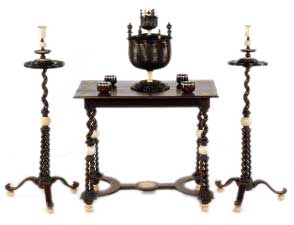17th Century England | Furnishings & Interiors
"a taste for luxury"
Aside from the more well known movements in architecture, leisure time, religion, and life generally, there also occurred in 17th century England major changes in the history of furnishings and interiors and in the world of interior decoration and furniture styles, changes that fundamentally altered the course of fashions in interior display, moving them away from "native" old English or Anglo Saxon modes and towards more classical, antique, or European styles.
These changes, taking place most clearly in the Restoration or Carolean period, bemoaned by some as a corruption and loss of a native, truly English mode of furnishing and interior styling in favour of slavish copying of showy, degenerate, French fashions, and welcomed by others as bringing England's furnishings into line with the great tradition and heritage of thousands of years of antique European culture and civilisation, can be best summarised as follows:
Home furnishings in England in the 17th century became more ornate and decorative instead of being merely useful things to sit on and eat off. In particular there was much use of the highly decorative art form of marquetry. We also see the increasing prevalence of chiefly ornamental furnishings such as gueridons and cheval fire screens in English interiors of the seventeenth century. Fire screens were made replete with exquisitely carved and gilded frames, and with panels of colourful velvet, taffeta and tapestry work.

Decorative table and candlestand set made of lignum vitae with ivory decoration, 1670's. The wood and the ivory are decorated with "rose engine turning", in which delicate circular patterns are incised into the material while it is spun on a lathe.
Additionally there was increased popularity for expensive foreign items such as mirrors especially Venetian style glass mirrors and also much furniture was richly gilded largely in imitation of French tastes in furnishings and interiors.
In the Country
However outside of the metropolis of London and the great country homes of England events in the realm of English country furniture, furnishings and interiors, in the cottage and small country house, were expectedly much slower to be affected by changes in life in 17th century England. Old English interiors and furnishings such as oak chests and cupboards continued to be made in traditional, time-honoured forms. Fixed and draw top dining tables (see drop leaf tables) made of oak and yew with matching, sturdy stools were in much demand well into the 18th century.
Of course much of the furnishings to be found in 17th century interiors in country homes were likely to have been there for generations but Evelyn the diarist is given to bemoan the adoption of foreign styles and manners and the taste for luxury in interior decoration and the "corrupting of ancient simplicity". The middle class in the countryside was growing and increasingly likely to toss away elements of old English interiors no longer thought to be of the modern fashion.
Evelyn pined for the old times when citizens of country England had "cupboards of ancient useful plate, whole chests of damask for the table......and the sturdy oaken bedstead, and furniture of the house, lasted one whole century; the shovelboard, and other long tables, both in hall and parlour, were as fixed as the freehold; nothing was moveable save joint stools, the black jacks, silver tankards, and bowls..."
An Example
We can gain a glimpse into the world of old English interiors from looking at the household inventory of one noble in the mid 17th century. Most of the furnishings detailed are of vintage sort, with much importance given to the decorative wall hangings and fabrics, to chairs, stools, and couches categorised according to their upholstery.
The hallway was furnished with a long trestle table covered in leather, a livery cupboard, a dozen or so chairs and stools, a leather sofa probably made during the Commonwealth period, a round table, three green carpets and seven cushions of "Turkey" work.

1660, Oak Bed Frame, carved and turned.
In the parlour or living room we note very similar items of furnishing. The main bedroom is furnished with two bedsteads with green hangings, a couch, a round table, a stand for water, and many chairs and stools. The six other bed rooms of the house were only spartanly decorated with bedsteads with feather pillows and mattresses, and one had a needlework chair, a screen, round table, and chest of drawers.

Circa 1610, A small furnishing panel used to add colour and warmth to bare rooms. Thick textile panels were often used as loose cushions or as fixed upholstery to make wooden chairs and stools more comfortable. The flowers depicted within the architectural arches are those commonly found in English gardens of the period: marigolds, carnations, a grape-vine, pansies, roses and a strawberry plant.
To summarise the picture above, the livery cupboard and trestle table are examples of very old style interiors dating back to medieval times while the use of chairs in particular shows more recent influences at play in the world of 17th century England furnishings.

